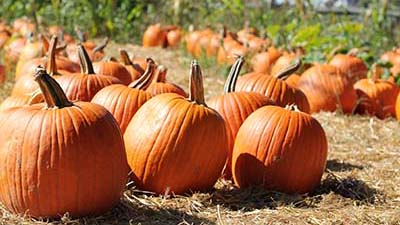How to Grow Pumpkins in Your Garden

Summary
Pumpkins prefer a sunny location and fertile, well drained soils. Incorporate plenty of organic matter and a complete fertilizer into the area before planting. Plant four to six seeds, 1-2 inches deep, in mounds 4 feet apart when soils are 65ºF. Thin the mounds after emergence to two plants. Transplant pumpkin 2 feet apart through black plastic for early maturity. Use row covers to protect the plants when planting before the frost-free period. After the vines develop runners, side dress with additional nitrogen fertilizer. Irrigation should be deep and infrequent. Plastic and organic mulches help conserve water and reduce weeding. Do not apply organic mulches until soils have warmed to 75ºF. Control insect and diseases throughout the year. Harvest pumpkins when the skin is hard and not easily broken when pressure is applied with a fingernail.
Recommended Pumpkin Varieties
Autumn Gold, Connecticut Field, and Spirit Hybrid are large (18-25 lb) fruited orange pumpkins that can be used for pies and carving. Jack Be Little, Wee-B-Little and Baby Bear are small (0.5-1.5 lb) orange fruited types suited for small children. Lumina is a medium (8-14 lb) white-skinned pumpkin used for painting. Big Max and Big Moon can produce fruits that weigh in excess of 200 pounds. There are many other good pumpkin varieties for sale at local gardening outlets and through seed catalogs. Most grow well in Utah.
How to Grow Pumpkins
Soils
Pumpkins prefer organic, rich, well-drained, sandy soils for best growth. Most soils in Utah will grow pumpkins provided the soils are well drained.
Soil Preparation
Before planting, determine fertilizer needs with a soil test and then follow the recommendations given with the test report. If fertilizer applications are warranted, work the fertilizer into the top 6 inches of soil. If you fertilize with compost, apply no more than 1 inch of well-composted organic matter per 100 square feet of garden area.
Plants
Pumpkins can be grown from seed or transplants. Seed should be planted 1-2 inches deep. Transplants should have three to four mature leaves and a well-developed root system.
Planting and Spacing
Pumpkins should be planted when soils are 65ºF or after frost danger has past. Plant four to six seeds in mounds 4 feet apart. After they have two leaves, thin to two plants per mound. Transplants should be planted 2-3 feet apart in the row with rows 4-6 feet apart. Avoid damaging the roots when planting which slows establishment and growth.
Mulches
Black plastic mulch warms the soil, conserves water, and helps control weeds. Plastic mulches allow earlier planting and maturity, especially with transplants. Lay down the plastic, secure the edges with soil, and cut holes for the seeds or transplants. When using plastic mulches and row covers, seeds or plants can be set out two weeks before the last frost. Do not apply organic mulches until soils are warmer than 75ºF. Grass clippings, straw, newspapers, etc., also conserve water and control weeds.
Row covers
Hotcaps, plastic tunnels and fabric covers protect seedlings and transplants from cool air temperatures. Row covers enhance growth and early maturity. Covers need to be removed when plants start to flower or when temperatures exceed 90ºF.
Water
Water deeply and infrequently, 1-2 inches per week. Use drip irrigation if possible. Mulch around the plants will conserve soil moisture and reduce weed growth. Irrigate so that moisture goes deeply into the soil. Reduce watering amounts as the fruits ripen.
Fertilization
After the vines develop runners, side dress with a nitrogen fertilizer (21-0-0) using 1-2 tablespoons per plant or mound. Incorporate the fertilizer at least 6 inches away from the plant.
Problems with Growing Pumpkins
Weeds
Plastic and organic mulches effectively control weeds. Hand weeding is needed to control weeds within the row. Heavy vine growth by pumpkins will also smother weeds.
Insects and Diseases
| Insect | Identification | Control |
|---|---|---|
| Aphids | Green or black soft-bodied insects that feed on underside of leaves. Leaves become crinkled and curled. May transmit virus diseases. Secreted honeydew makes plants appear shiny, wet, or sticky. | Use insecticidal soaps or strong water stream to dislodge insects. |
| Squash Bugs | Adults are gray or brown and 5/8 inch long. Adults and immature forms suck the sap from leaves leaving them speckled before they wither and die. | Trap adults under boards, check each morning and kill pests. Hand pick adults, immatures and eggs off leaves. |
| Cucumber Beetles | Adults have stripes or spots and feed on leaves and vines which reduces vigor. May transmit bacterial disease. Larvae bore into roots and stems causing plants to wilt and die. | Application of chemicals at first appearance is needed to control this pest. |
| Disease | Symptom | Control |
| Powdery Mildew | White fungal patches start on older leaves. The disease eventually spreads to all plant parts. The foliage dies, exposing fruits to the sun, which causes premature ripening. | Plant resistant varieties. |
| Wilt Diseases | Leaves wilt on one or more vines. Plants often die. Streaking, slime formation, or gummy exudates visible on stems.Diseases are caused by different pathogens. | Identify causal disease. Treat disease as recommended once identified. |
| Virus | Leaves are light green, mottled, malformed, dwarfed and curled. Early infection affects fruit shape and flavor. An aphid-transmitted disease. | Control aphids. Destroy severely infected plants. |
How to Harvest and Store Pumpkins
Pumpkins take 45-55 days to mature after flowering. Pumpkins are mature when they are fully colored, when the vine begins to die back, and when the rind is hard and impervious to scratching from a fingernail. Mature fruits should be harvested with the stem attached and stored where they will not freeze.
Pumpkin Plant Productivity
Plant one to two hills per person for fresh use. Expect 25-50 fruits per 100 feet, depending on variety and fruit size.
Frequently Asked Questions
How can I grow pumpkins that weigh more than 100 pounds? First, you need to plant a variety that produces very large fruits.
Allow at least 100 square feet of garden space per hill. Plant 6-8 seeds per hill and later thin to the best one or two plants. After flowering starts, remove the first two or three female flowers to keep the plants growing more leaf are before setting fruit. Allow a single fruit to develop and pick off all remaining female flowers that form on the plant. Keep the soil well-watered and feed the plant regularly. Control all insects and disease. By keeping the stresses to a minimum, the plant can then put all of its growth into the development of the large fruit.
Do pumpkins, squash and gourds cross-pollinate with each other?
Pumpkins, squash and gourds are members of the botanical genus classification of Cucurbita. The varieties within the same botanical species can cross-pollinate. Varieties from different species generally do not. For example, zucchini can cross with pumpkin, acorn or spaghetti squash because they are all members of the same botanical species (Cucurbita pepo). Cross-pollination does not affect the taste, shape or color of the current season's fruit. However, if you save your own seed from these fruits, you may see oddities the next year. Since bees carry pollen for many miles, pollinate fruits by hand then bag the flowers to make sure out crossing with a different variety doesn’t happen.
View En Espanol
Published February 2020
Utah State University Extension
Peer-reviewed fact sheet
Download PDF
Authors
Rick Hefelbower and Dan Drost
Related Research









